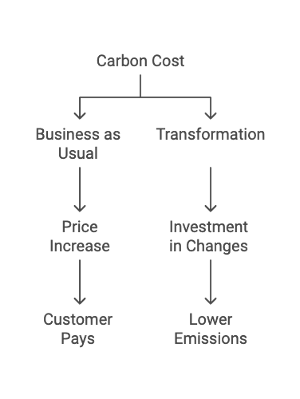Why Putting a Price on Carbon Isn't Enough
When companies simply pay carbon costs and continue business as usual, something has gone wrong. Here's why carbon pricing was meant to transform business, not just add to its costs.
Carbon pricing wasn't designed to be just another cost of doing business – it was meant to transform how businesses operate. Yet many companies still treat it exactly that way, missing both the point and the opportunity that carbon pricing creates.

The Real Purpose of Carbon Pricing
Imagine you're a parent trying to discourage your teenager from staying out late. Would you consider it a success if they just used their allowance to pay your 'late-night fee' and kept coming home at 3 AM? Of course not. The fee was meant to change behaviour, not become a transaction.
Carbon pricing works the same way. Whether through taxes or trading systems, putting a price on carbon isn't about collecting money - it's about pricing a negative externality and driving companies to innovate their way to a lower carbon footprint.
When Carbon Pricing Fails
Let's look at a real example. When Norway first implemented carbon taxes in the 1990s, many oil and gas companies simply paid the tax and continued flaring gas. The policy wasn't driving change. But when they adjusted the system to combine pricing with specific technology requirements, companies began investing in electrification and carbon capture. The lesson? Price alone isn't enough – it needs to be high enough and combined with clear alternatives.
It requires a functioning ecosystem - from debt and equity markets to technology providers - to enable real change.
Whilst the burden of the regulations land on corporates, the uncomfortable truth is that if there are no alternatives, or easy access for companies to decarbonise, then it makes it incredibly difficult for management teams and CFOs to work out how to mitigate these costs. Understandably, this creates frustrations and lack of direction especially when these policies are impacting the fundamental foundations on how a business operates.
Signals That Drive Change
Effective carbon pricing sends three critical signals:
Today's emissions are tomorrow's liability
Innovation creates competitive advantage
Early movers capture the best opportunities to de-risk their net-zero journey
First, today's emissions become tomorrow's liability. By pricing what was once treated as free, carbon pricing forces companies to treat their emissions like any other business cost that needs managing.
Second, innovation unlocks competitive advantage. Companies that attack this as an innovation challenge rather than a compliance cost often find unexpected benefits. Take Heidelberg Cement - their carbon reduction efforts led to lower energy use and better margins, proving that efficiency and profitability can align.
Third, early movers secure the best opportunities. With limited high-quality carbon reduction projects available, companies moving first get their pick of cost-effective solutions. They build expertise while others are still planning, creating a widening advantage as carbon prices rise.
Making Carbon Pricing Work
The most successful carbon pricing systems share three characteristics:
Predictably rising costs that encourage long-term planning
Clear alternatives to high-carbon processes
Support for innovation and transformation
What does this mean for finance professionals?
For strategic finance professionals, today's carbon pricing policies are just the beginning. While others focus on minimal compliance, the real opportunity lies in seeing these prices as signals of accelerating change.
Whether in established markets or developing economies, companies that move early to transform their operations will build lasting advantages. The question isn't whether carbon prices will rise, but whether you'll be ahead of the curve when they do.
What's your next step in this transformation? Share your thoughts on how you're helping your management team think beyond compliance.
This article is part of our Carbon Markets & Corporate Strategy series. Each week, we explore how financial professionals can turn climate-related challenges into strategic opportunities.
Coming up in this series:
How leading companies are getting ahead of carbon prices - and the strategies you can implement today
The real cost of delayed action in carbon markets - what the numbers reveal
Why developing markets might leap ahead in the carbon transition - and what it means for global competition
Subscribe to join finance professionals building tomorrow's market advantages.






